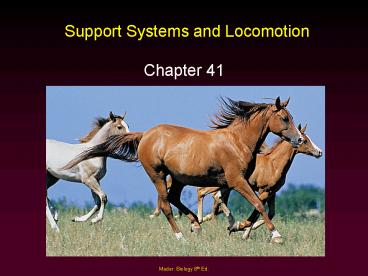Support Systems and Locomotion - PowerPoint PPT Presentation
1 / 29
Title:
Support Systems and Locomotion
Description:
Human Skeletal System ... Twelve pairs of ribs. Seven pairs of true ribs. Connect ... A muscle at rest exhibits tone, dependent upon tetanic contractions. ... – PowerPoint PPT presentation
Number of Views:200
Avg rating:3.0/5.0
Title: Support Systems and Locomotion
1
Support Systems and Locomotion
- Chapter 41
2
Outline
- Hydrostatic Skeleton
- Exoskeletons
- Endoskeletons
- Human Skeletal System
- Axial Skeleton
- Appendicular Skeleton
- Human Muscular System
3
Hydrostatic Skeleton
- A fluid-filled gastrovascular cavity, or a
fluid-filled coelom, can act as a hydrostatic
skeleton. - Offers support and resistance to the contraction
of muscles for mobility. - Annelids are segmented, and have septa that
divide the coelom into compartments.
4
Locomotion in an Earthworm
5
Exoskeletons and Endoskeletons
- Exoskeleton - External Skeleton
- Molluscs (calcium carbonate) and Arthropods
(chitin). - Endoskeleton - Internal Skeleton
- Echinoderms and vertebrates.
- Bone and cartilage which grows with the animal.
- Does not limit space for internal organs, and
supports greater weight.
6
Vertebrate Endoskeleton
7
Human Skeletal System
- Skeleton supports and protects the body while
also permitting flexible movement. - All bones store calcium and phosphate ions, and
certain bones produce red blood cells.
8
Bone Growth and Renewal
- Cartilage structures in early development act as
models for future bones. - Calcium salts deposited in matrix by cartilage
cells and later by osteoblasts. - Endochondral ossification
- In adults, osteoclasts break down bone, remove
worn cells, and deposit calcium in the blood. - Osteoclasts and osteoblasts work together to heal
broken bones.
9
Anatomy of a Long Bone
- Longitudinal section of a long bone shows a
hollow cavity, medullary cavity, bounded at the
sides by compact bone and at the end by spongy
bone. - Compact bone contains many osteons where
osteocytes lie in lacunae. - Spongy bone has numerous bars and plates
separated by irregular spaces. - Spaces filled with red bone marrow.
10
(No Transcript)
11
The Axial Skeleton
- The axial skeleton lies in the midline of the
body and consists of the skull, vertebral column,
sternum, and ribs.
12
The Skull
- Formed by cranium and facial bones.
- Bones of cranium contain sinuses.
- Major bones are named after the lobes of the
brain and the facial bones. - Foramen magnum is opening at base of skull for
spinal cord to pass.
13
The Skull
14
Vertebral Column
- Vertebral column supports the head and trunk and
protects the spinal cord and roots of spinal
nerves. - Cervical - Neck
- Thoracic - Thorax
- Lumbar - Small of back
- Sacral - Sacrum
- Coccyx - Tailbone
- Intervertebral disks of fibrocartilage act as
padding.
15
Rib Cage
- Thoracic vertebrae are part of the rib cage.
- Twelve pairs of ribs.
- Seven pairs of true ribs.
- Connect directly to sternum.
- Five pairs of false ribs.
- Do not connect directly to sternum.
- Rib cage protects the heart and lungs, and
assists breathing.
16
The Rib Cage
17
The Appendicular Skeleton
- The appendicular skeleton consists of the bones
within the pectoral and pelvic girdles and the
attached limbs. - Pectoral girdle - Arm and hand.
- Pelvic girdle - Leg and foot.
18
(No Transcript)
19
(No Transcript)
20
Classification of Joints
- Fibrous Joints - Immovable.
- Between cranial bones.
- Cartilaginous Joints - Slightly Movable.
- Between vertebrae.
- Synovial Joints - Freely Movable.
- Bones separated by a cavity.
- Ligaments bind bones together.
- Knee
21
Knee Joint
22
Human Muscular System
- Skeletal muscles are attached to the skeleton by
fibrous connective tissue, tendons. - Can only pull, cannot push.
- Antagonistic pairs.
- A muscle at rest exhibits tone, dependent upon
tetanic contractions. - Maximal sustained contractions.
23
Antagonistic Muscle Pairs
24
Microscopic Anatomy and Physiology
- Sarcolemma
- Plasma membrane
- Sarcoplasmic Reticulum
- Modified endoplasmic reticulum.
- Myofibrils
- Contractile portions of muscle fiber.
- Sarcomeres
- Protein filaments within contractile units.
- Myosin
- Actin
25
Sliding Filament Model
- Sliding Filament model states actin filaments
slide past myosin filaments because myosin
contain cross-bridges which pull the actin
filaments inward. - Working muscles require ATP.
- Myosin breaks down ATP.
- Sustained exercise requires cellular respiration
for the generation of ATP.
26
Muscle Innervation
- At a neuromuscular junction, nerve impulses bring
about the release of a neurotransmitter that
signals a muscle fiber to contract.
27
Neuromuscular Junction
28
Review
- Hydrostatic Skeleton
- Exoskeletons
- Endoskeletons
- Human Skeletal System
- Axial Skeleton
- Appendicular Skeleton
- Human Muscular System
29
(No Transcript)































